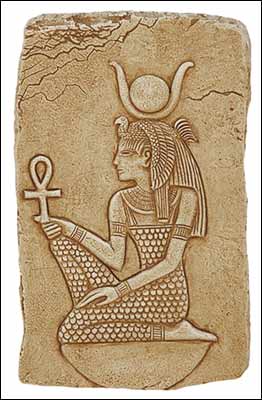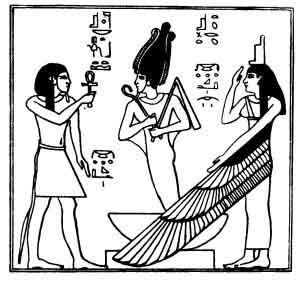Kundalini in Egypt

Some of the deities and symbols of Kundalini in the ancient Indian tradition have close parallels in the contemporaneous early Egyptian civilization.
For instance, the ancient deity Isis is strikingly similar in many respects to Shakti. She is the mother-goddess, the ideal wife, the bestower of fertility, life, magic and good fortune.
She demonstrates her power by resurrecting, or giving new life to, her murdered and dismembered husband Osiris. This symbolizes the ability of Kundalini to build the fetus in the womb, and to transform the brain and nervous system of the individual so that they can experience cosmic consciousness. The term ‘rebirth’ has often been used to describe the process of physical and spiritual transformation brought about in one in whom Kundalini is awakened.
Isis is almost always depicted with a solar or lunar orb between two horns above her head, in the same way that Lord Shiva has the crescent Moon on his. She also usually carries the ankh in her hand, a symbol that is closely akin to the lingam-yoni of India, indicating the union of the female and male principles.
The ‘Tet’ symbol (rod with a curved end) held by her husband Osiris is said to represent the backbone. This indicates knowledge of the crucial part played by the spine in the Kundalini process.


Isis is aided in her resurrection of Osiris by Hermes, or Thoth, god of wisdom and magic. He carries the Staff of Hermes, or caduceus, with two serpents intertwined around a rod (the spine), an unmistakable symbol of Kundalini. It survives to this day as an evocative icon of medical practice.
One difference between the Egyptian and Indian traditions is that the former seems to have been focused more on the development of paranormal abilities than transcendence. Kundalini has the ability to bestow powerful charisma and paranormal abilities, which can enhance the ability to rule.

